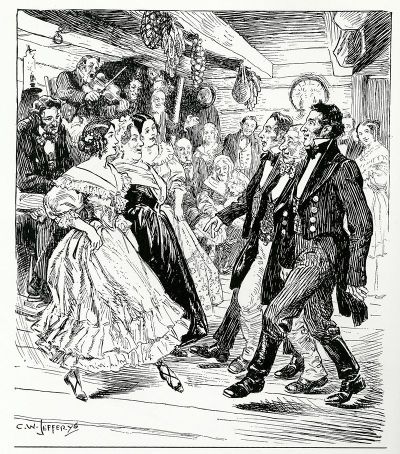Annotation:Six Hand Reel
X:1 T:Six Hand Reel M:2/4 L:1/8 R:Reel S:Ford – Traditional Music in America (1940) Z:AK/Fiddler’s Companion K:G (3D/E/F/|G{A}G/F/ G/A/B/c/|(d/B/)g/e/ d/B/A/c/|B/E/{F}E/D/ E/F/G/A/|(B/G/)(A/F/) G/F/E/D/| D/G/{A}G/F/ G/A/B/c/|d/(B/g/)(e/ d/)B/A/c/|B/E/{F}E/D/ E/F/G/A/|(B/d/)A/F/ G:| |:B|(B/e/)e/d/ e>f|(g/e/)a/f/ g/f/e/d/|B/d/d/e/ d>e|(g/e/)a/f/ g/f/e/d/| (B/e/)e/d/ e>f|(g/e/)a/f/ g/f/e/d/|B/E/{F}E/D/ E/F/G/A/|B/d/A/F/ G:|

Part of the confusion regarding the supposed antiquity of the Virginia Reel (with a capital 'R') owes to the existence of older six-handed Virginia reels (with a lowercase 'r'). These reels were danced with three couples in longways sets, the men on one side and the women on the other, and as in the four-handed reels, they involved footwork in place ("setting steps") that alternated with a traveling figure. Descriptions of the figures vary, but they typically included a sashay down the middle and back, heys within each of the lines, and a cast-off down the outside. Like the four-handed reels, these six-handed reels did not require a large dance floor, so they could be danced in houses and other small spaces. This, and the fact that attendance at dancing school was not required to learn the simple repetitive figures, made these dances popular with all classes of people, rural as well as urban. During the late-eighteenth and early-nineteenth centuries, six-handed reels were popular throughout North America, from Canada to the Mississippi. They were especially prevalent in the South, however, where they (and the dance tunes that accompanied them) becomes known as "Virginia reels," the term "Virginia" used as a generic term for the American South, differentiating these American dances from the four-handed "Scotch Reels" of the British Isles.[1]
In the case of Ford's "Six Hand Reel" the tune well-known as "Temperance Reel" is associated with the dance.
- ↑ Phil Jamison, Hoedowns, Reels, and Frolics: Roots and Brances of Southern Appalachian Dance, 2015, p. 92.
